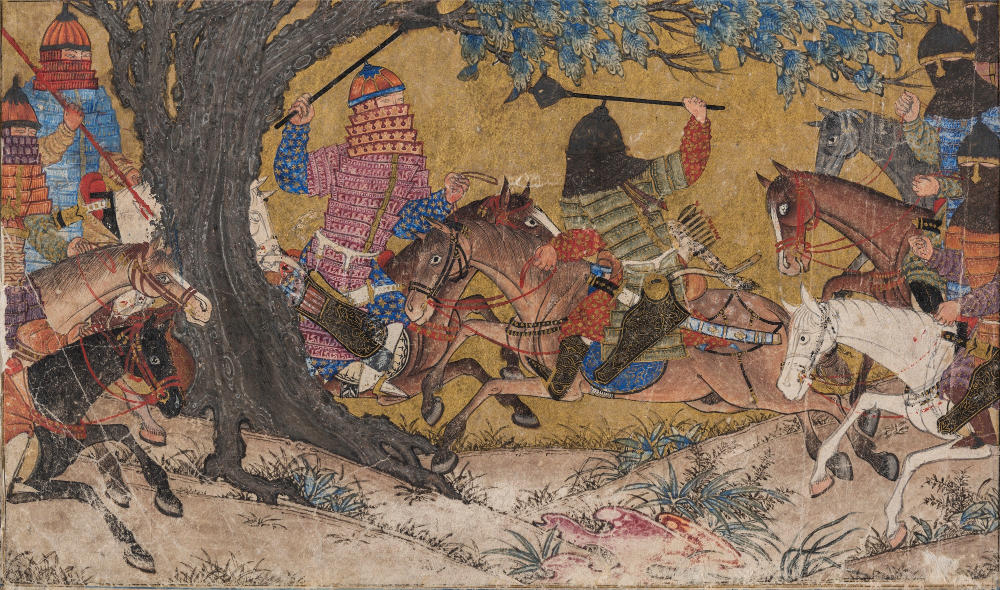Find the perfect fit with Amazon Prime. Try Before You Buy.

Try Amazon Fresh
Ilkhanid Illustration
Great Mongol (Demotte) Shāh-Nāmeh
Chapter 21 - The Ashkanians (200 years)
Ardashir defeats Bahman
Tabriz, c.1340-1350

A larger image of 'Ardashir defeats Bahman' in the Great Mongol (Demotte) Shāh-Nāmeh. Detroit Institute of Arts 35-54.
Islamic
Folio from the Great Mongol Shahnama: Ardashir Battles Bahman, Son of Ardavan, c. 1335
ink, colors and gold on paper
The Shahnama, The Book of Kings, was written in the eleventh century by the Persian poet Firdausi. It extols the valor of the ancient kings of Iran.
The richly colored painting here depicts the historic hero Ardashir (on the right) as he battles Bahman (on the left), the son of his enemy, for the crown of Persia.
This copy of the Shahnama was probably commissioned between 1335 and 1336 by the Vizier (prime minister) Ghiyath al-Din in the Mongol capital city of Tabriz.
Persian painting was born there, with the development of a Mongol style influenced by the Baghdad school and Chinese art.
The Persian aesthetic integrates a sense of drama with an expanded use of color.
Source: Detroit Institute of Arts.
Plate 41 in: M. GORELIK, "Oriental Armour of the Near and Middle East from the Eighth to the Fifteenth Centuries as Shown in Works of Art", in: Islamic Arms and Armour, ed. ROBERT ELGOOD, London 1979
41 Miniature from 'Demotte' Shāh-Nāmeh, Tabriz, c.1340-1350. (Detroit Institute of Arts. accession no. 35-54)
p.38
The second khuyagh armour style was a calf-length coat slit from the neck to the hem in the front, and from the sacrum to the hem in the back,
which enabled the warrior to sit a horse (40-41).
The coat comprised two vertical halves joined by a flexible seam down the back and fastened on the chest by clasps: the vents in the skirt of the coat created two wide tassets.
53 F19.184
Ardashir Battling Bahman, Son of Ardavan
Image: 17 x 29 cm (6¾ x 11⅜ in.)
Detroit Institute of Arts, Founders Society Purchase, Edsel B. Ford Fund
(35.54)
The account of Iskandar ends with his death.
The narrative moves next to the rule of Ardavan, last of the Parthian kings.
Ardavan had heard of the prowess of a gifted and gallant youth, Ardashir, born of a local princess and a shepherd, and summoned him to the court to live with his sons.
Ardashir fell out of favor when he surpassed the king’s sons at hunting, and he was banished to the stables.
Subsequently, Ardavan was warned by his sages that one of his servants would soon overthrow him.
Fearing for his life, Ardashir escaped from the court with his beloved, Gulnar, Ardavan’s favorite slave-girl, and the two were pursued by the king.
Ardavan, however, was unable to catch up with the couple and ordered his son Bahman to continue the chase.
Reaching his homeland, Ardashir gathered an army to face Bahman, and a fierce battle ensued.
Finally, Ardashir charged at Bahman, who fled wounded.
The painting shows the combatants in the center with their armies at the sides.1
The charging Ardashir is depicted with his back to the viewer.
Although the title above was originally inscribed “Ardashir battling Ardavan,” the text above describes the confrontation between Ardashir and Bahman,
and the words “Bahman, son of” have been inserted before “Ardavan” in the title by a later hand.
1. Grabar and Blair 1980, pp. 138-39, no. 4.1.
Source: pp. 256-7, The Legacy of Genghis Khan Courtly Art and Culture in Western Asia 1256-1353
Detroit, Detroit Institute of Arts
Title of Work: Shahnama (Great Mongol)
Manuscript: 35.54
Chapter 21 - The Ashkanians (200 years)
Scene: Ardashir defeats Bahman
Dimensions (h x w): 170 x 290 mm
Format: Rectangular within borders
Reconstructed Folio: 181r
Gregorian Date: 1335 (circa)
School: Tabriz
Source: Shahnama Project
Previous: f. 180r: 'Ardashir meets Gulnar'. Great Mongol (Demotte) Shahnama. Tabriz, Persia. Ilkhanid Illustration. Collection des Musées d’Art et d’Histoire, Geneva, 1971-0107-0003.
Next: f. 181v: 'Ardavan led captive before Ardashir'. Great Mongol (Demotte) Shahnama. Tabriz, Persia. Ilkhanid Illustration. Sackler Gallery S1986.103.
Back to the Great Mongol (Demotte) Shah-Nameh. Tabriz, Ilkhanid Persia.
Persian Cavalrymen c.1335 in Armies of the Middle Ages, Volume 2 by Ian Heath, based on the 'Great Mongol' (Demotte) Shahnama


